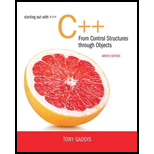
Group Project
25. Travel Expenses
This
• One student should design function main, which will call the other functions in the program. The remainder of the functions will be designed by other members of the team.
• The requirements of the program should be analyzed so each student is given about the same workload.
• The parameters and return types of each function should be decided in advance.
• Stubs and drivers should be used to test and debug the program.
• The program can be implemented as a multi-file program, or all the functions can be cut and pasted into the main file.
Here is the assignment: Write a program that calculates and displays the total travel expenses of a businessperson on a trip. The program should have functions that ask for and return the following:
• The total number of days spent on the trip
• The time of departure on the first day of the trip, and the time of arrival back home on the last day of the trip
• The amount of any round-trip airfare
• The amount of any car rentals
• Miles driven, if a private vehicle was used. Calculate the vehicle expense as $0.27 per mile driven
• Parking fees (The company allows up to $6 per day. Anything in excess of this must be paid by the employee.)
• Taxi fees, if a taxi was used anytime during the trip (The company allows up to $10 per day, for each day a taxi was used. Anything in excess of this must be paid by the employee.)
• Conference or seminar registration fees.
• Hotel expenses (The company allows up to $90 per night for lodging. Anything in excess of this must be paid by the employee.)
• The amount of each meal eaten. On the first day of the trip, breakfast is allowed as an expense if the time of departure is before 7 a.m. Lunch is allowed if the time of departure is before 12 noon. Dinner is allowed on the first day if the time of departure is before 6 p.m. On the last day of the trip, breakfast is allowed if the time of arrival is after 8 a.m. Lunch is allowed if the time of arrival is after 1 p.m. Dinner is allowed on the last day if the time of arrival is after 7 p.m. The program should only ask for the amounts of allowable meals. (The company allows up to $9 for breakfast, $12 for lunch, and $16 for dinner. Anything in excess of this must be paid by the employee.)
The program should calculate and display the total expenses incurred by the businessperson, the total allowable expenses for the trip, the excess that must be reimbursed by the businessperson, if any, and the amount saved by the businessperson it the expenses were under the total allowed.
Input Validation: Do not accept negative numbers for any dollar amount or for miles driven in a private vehicle. Do not accept numbers less than 1 for the number of days. Only accept valid times for the time of departure and the time of arrival.
Want to see the full answer?
Check out a sample textbook solution
Chapter 6 Solutions
Starting Out with C++ from Control Structures to Objects (9th Edition)
- Please solve and answer the questions correctly please. Thank you!!arrow_forwardConsidering the TM example of binary sum ( see attached)do the step-by-step of execution for the binary numbers 1101 and 11. Feel free to use the Formal Language Editor Tool to execute it; Write it down the current state of the tape (including the head position) and indicate the current state of the TM at each step.arrow_forwardI need help on inculding additonal code where I can can do the opposite code of MatLab, where the function of t that I enter becomes the result of F(t), in other words, turning the time-domain f(t) into the frequency-domain function F(s):arrow_forward
 C++ Programming: From Problem Analysis to Program...Computer ScienceISBN:9781337102087Author:D. S. MalikPublisher:Cengage LearningProgramming Logic & Design ComprehensiveComputer ScienceISBN:9781337669405Author:FARRELLPublisher:Cengage
C++ Programming: From Problem Analysis to Program...Computer ScienceISBN:9781337102087Author:D. S. MalikPublisher:Cengage LearningProgramming Logic & Design ComprehensiveComputer ScienceISBN:9781337669405Author:FARRELLPublisher:Cengage Microsoft Visual C#Computer ScienceISBN:9781337102100Author:Joyce, Farrell.Publisher:Cengage Learning,
Microsoft Visual C#Computer ScienceISBN:9781337102100Author:Joyce, Farrell.Publisher:Cengage Learning, C++ for Engineers and ScientistsComputer ScienceISBN:9781133187844Author:Bronson, Gary J.Publisher:Course Technology Ptr
C++ for Engineers and ScientistsComputer ScienceISBN:9781133187844Author:Bronson, Gary J.Publisher:Course Technology Ptr EBK JAVA PROGRAMMINGComputer ScienceISBN:9781337671385Author:FARRELLPublisher:CENGAGE LEARNING - CONSIGNMENT
EBK JAVA PROGRAMMINGComputer ScienceISBN:9781337671385Author:FARRELLPublisher:CENGAGE LEARNING - CONSIGNMENT Systems ArchitectureComputer ScienceISBN:9781305080195Author:Stephen D. BurdPublisher:Cengage Learning
Systems ArchitectureComputer ScienceISBN:9781305080195Author:Stephen D. BurdPublisher:Cengage Learning





